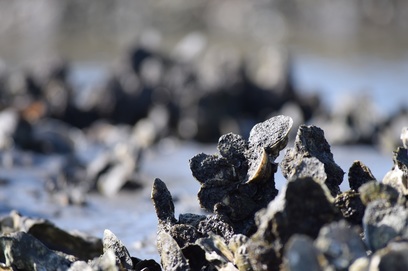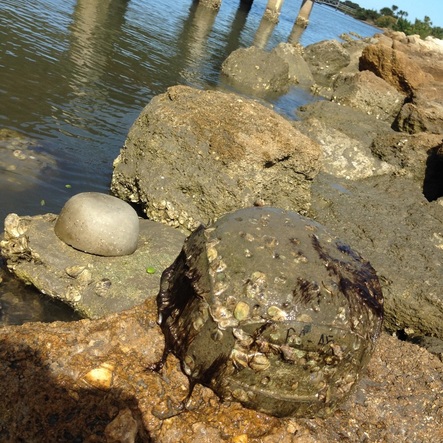Why oysters?

Oysters are a reef-building foundation species that create complex, three-dimensional reefs that create nursery habitat for commercially-important fish species, provide shoreline protection, sequester carbon, and enhance water quality. These reefs have also supported a historically productive oyster industry that, at its peak, supported over 50,000 jobs in the United States. Centuries of overexploitation, however, led to global degradation of oyster reefs. Other stressors such as disease, habitat destruction, and eutrophication further exacerbated oyster reef loss, and, to date, 85% of oyster reefs have been lost worldwide.
I am interested in exploring the efficacy of different restoration materials, particularly how the spatial complexity of these substrates influences community assembly and predator-prey interactions. I intend to then use this knowledge to inform and optimize the design of oyster reef restoration structures that can enhance oyster reef settlement and persistence.
I am interested in exploring the efficacy of different restoration materials, particularly how the spatial complexity of these substrates influences community assembly and predator-prey interactions. I intend to then use this knowledge to inform and optimize the design of oyster reef restoration structures that can enhance oyster reef settlement and persistence.
Projects
Exploring the role of spatial complexity in oyster settlement and survival on artificial restoration reefs
Natural oyster habitat is spatially complex with crevices formed by individuals growing on top of one another; complexity that provides some refuge from predation and thereby enhances oyster spat settlement and survival. To test the hypothesis that such surface heterogeneity is critical for sustaining oyster spat on artificial reefs used in restoration, we constructed concrete reef domes that mimicked this complexity and deployed them along the shore of the Matanzas River in Marineland, FL.
|
Marine wood-borers:
Studying the susceptibility of four tree species to shipworm infestations
For centuries, wood has been used as a construction material for both terrestrial and aquatic structures. In marine environments, however, wood is exposed to numerous wood-boring organisms known as shipworms that compromise its structural integrity. Shipworms are bivalve molluscs that settle on wooden substrates and bore into the wood to create a burrow that serves as shelter. These organisms can release millions of larvae at a time and are easily transported by currents, ballast water, and driftwood, making them almost ubiquitous in marine environments. Shipworms are quick to settle on any available wooden structure, which poses a problem for dock builders, boat owners, and anyone building wooden marine structures.
I am interested in understanding how different tree species respond to shipworm infestations and how shipworm prevalence differs depending on the distance from the sediment layer. To do this, I have selected four tree species (laurel oak, sweetgum, crepe myrtle, and black mangrove) and built ladders using branches from each. These ladders were then deployed in tidal creeks in the Matanzas River in St. Augustine, FL where they would be exposed to shipworms.
To compare the susceptibility of each species to shipworm infestations and how they differ as you move up in the water column, I will count the number of boring holes in each branch and compare them between species and between distances from the sediment. X-ray will then be used to estimate the area of shipworm burrows inside each branch. Finally, to compare the effects of shipworm boring on trees' structural integrity, I will perform strength tests on branches that have not been exposed to shipworms and on the branches that were deployed in the field.
I am interested in understanding how different tree species respond to shipworm infestations and how shipworm prevalence differs depending on the distance from the sediment layer. To do this, I have selected four tree species (laurel oak, sweetgum, crepe myrtle, and black mangrove) and built ladders using branches from each. These ladders were then deployed in tidal creeks in the Matanzas River in St. Augustine, FL where they would be exposed to shipworms.
To compare the susceptibility of each species to shipworm infestations and how they differ as you move up in the water column, I will count the number of boring holes in each branch and compare them between species and between distances from the sediment. X-ray will then be used to estimate the area of shipworm burrows inside each branch. Finally, to compare the effects of shipworm boring on trees' structural integrity, I will perform strength tests on branches that have not been exposed to shipworms and on the branches that were deployed in the field.
Testing the efficacy of four wood treatments against shipworm infestations
Shipworms have been a problem for as long as humans have used wood in marine environments. They have decimated docks and destroyed ships through their burrowing. There has been considerable study of these organisms and different approaches have been tried in order to protect wooden structures against shipworm infestations, but to date there is no treatment that is 100% effective in preventing shipworm boring. There are, however, certain approaches that protect wood to a certain extent, and while they do not prevent infestations, they do slow down shipworm settlement. A popular approach is to use copper, either in pressure-treated wood or in paint. However, in large quantities, these compounds can begin to affect other organisms in the environment due to their toxic nature.
I am interested in comparing the efficacy of alternative, green treatments against more common, commercial approaches. To do this, I used pressure-treated wooden posts, wooden posts treated with copper paint, posts wrapped with triple-layer, weather resistant tape, posts wrapped with a silicone layer, and untreated wooden posts (as a control). I deployed these posts at two sites along the Matanzas River in St. Augustine, FL and will compare their initial and final strengths, the number of shipworm boring holes, and the area of shipworm burrows.
I am interested in comparing the efficacy of alternative, green treatments against more common, commercial approaches. To do this, I used pressure-treated wooden posts, wooden posts treated with copper paint, posts wrapped with triple-layer, weather resistant tape, posts wrapped with a silicone layer, and untreated wooden posts (as a control). I deployed these posts at two sites along the Matanzas River in St. Augustine, FL and will compare their initial and final strengths, the number of shipworm boring holes, and the area of shipworm burrows.
Presentations & Posters
North Florida Marine Science Symposium, Cedar Key, FL - January 2016
Poster
GTM NERR State of the Reserve, St. Augustine, FL - February 2016
Poster
University of Florida, ESSIE Poster Symposium, Gainesville, FL - February 2016
Poster
Benthic Ecology Meeting, Portland, Maine - March 2016
Oral Presentation
Poster
GTM NERR State of the Reserve, St. Augustine, FL - February 2016
Poster
University of Florida, ESSIE Poster Symposium, Gainesville, FL - February 2016
Poster
Benthic Ecology Meeting, Portland, Maine - March 2016
Oral Presentation
Fellowships & Awards
University of Florida Graduate Student Fellowship
Tropical Conservation and Development Fellowship
Tropical Conservation and Development Fellowship

